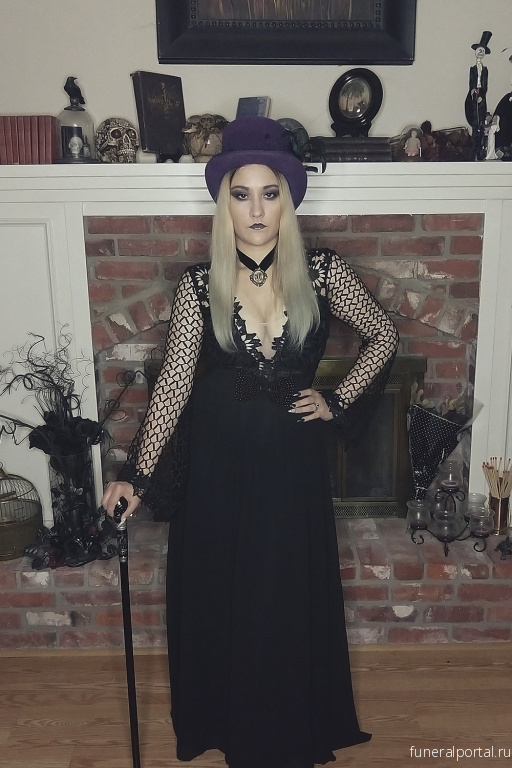By: Channa Steinmetz

Courtney Lane, Never Forgotten
For as long as Courtney Lane can remember, she’s had a fascination with the ways people memorialize their deceased loved ones, the Kansas City hair artist said.
“I had a family who didn’t shelter me from the concept of death,” Lane recalled. “When I was 5 or 6 years old, my grandmother took me on a tour of the above ground cemeteries in New Orleans. I thought the memorials were beautiful, and that really sparked this lifelong interest.”

A family hair ring featuring a basketweave pattern of a mother’s and father’s hair with a lock of baby’s first haircut overtop; photo courtesy of Never Forgotten
Obsessed with finding answers to how different communities and eras mourned the dead, Lane stumbled upon hair art. (It’s what it sounds like: art made from real human hair, often with distinct personal and emotional significance.)
“It just clicked,” she said. “Because not only is this a way to memorialize your loved one, but it’s using an actual part of your loved one that’s identifiable to them — it’s the hair that you’ve been able to see and touch while they were living.”
Lane studied hair art for several years before becoming a Victorian hair artist herself and starting her business — Never Forgotten.
“I did think for quite a long time that [hair art] was truly a lost art form,” Lane noted.
But after deciphering books of antiquated English and years of trial and error, Lane nailed down techniques abandoned by time. Founding Never Forgotten in 2015, she shares her own hair art creations and makes custom art and jewelry pieces for customers.
Lane’s clients request hair art for a number of reasons: to grieve or memorialize a loved one, as a romantic gesture between spouses or as a familial piece.
“A lot of mothers want to do something with their baby’s first haircut, because whether we realize it or not, we still have a habit of saving hair as a society,” she explained. “We just don’t make it into artwork or wear it on jewelry the way we used to.”
Click here to shop Never Forgotten’s hair art.

A Mother's Day gift made with a daughter's hair; photo courtesy of Never Forgotten

Victorian Era hair; photo courtesy of Never Forgotten

A single, miniature flower with a dime for size comparison; photo courtesy of Never Forgotten

A cat hair memorial for a deceased pet; photo courtesy of Never Forgotten
An (almost) forgotten history
A lot of people have a visceral reaction — whether it’s disgust or intrigue — when they learn about hair art for the first time, Lane shared.

An unfinished and unframed piece originally started by an artist in the Victorian era and later restored and finished by Courtney Lane using antique hair; photo courtesy of Never Forgotten
Why? An art form that was once seen as fashionable fell from popularity, it’s become a rarity today. Lane deep dives into several reasons why hair art became obsolete on her YouTube channel, Hair and Now.
“The sentiment of hair is very old; I’ve found early iterations of the types of techniques I do dating back as early as the 1500s,” Lane explained. “From there, it just grew and grew with more complicated patterns.
“In the 1800s was when you would start seeing huge, elaborate wreaths made out of human hair and incredibly intricate braids to be put into gold for jewelry,” she continued. “So it really was a very normal thing in the Victorian era; it became highly fashionable!”
In her research, Lane found that hair art popped up in various cultures at different times, proving to her that hair is inherently sentimental, she said.
“Even today, I will have people contact me and say, ‘When my mother died 10 years ago, I snipped a lock of her hair, and I never told anyone because I felt like I was weird to do this,’” Lane shared. “This was someone who didn’t even know that hair has an incredibly long history.”
In addition to being an artist, Lane is also a historian who — before the COVID-19 pandemic — occasionally lectures on the history of hair art at colleges and conferences.
“More recently, I’ve been trying to take that [education] to YouTube — to not only teach the history about this art form, but to also make it more fun and accessible,” Lane noted.
Lane also hosts classes on her Patreon where students can have access to hair art tutorials and her personal tips and tricks. It is important for her to offer this service, she said, in order to ensure that traditional artform is never forgotten.
Click here to watch videos on Courtney Lane’s YouTube channel, Hair and Now.
Ehlers-Danlos syndrome
Before becoming a Victorian hair artist, Lane worked as a choreographer and dancer. Around that time, she also began walking with a cane because of Ehlers-Danlos syndrome (EDS), causing her to switch career paths.

Courtney Lane, Never Forgotten
EDS is a genetic disorder that affects the connective tissues in the body. Its symptoms include hypermobility in the joints that may cause dislocation, along with fragile skin and chronic fatigue.
“Before the age of 2, I could pop my own dislocated elbows back into place, so I’ve always been acutely aware of my anatomy and how fragile it is,” she recalled. “In the midst of endless doctor appointments, I’ve never felt invincible as many young people do.”
Where some may see her EDS as an impediment, Lane said, she sees her condition as a liberation that has opened her eyes to several truths — truths that have set her wants and goals in motion.
“Death has always seemed possible, and at a time when my medical history was riddled with question marks, the thought would often occur to me that it may come for me sooner than my healthier peers,” Lane said. “This has helped me not only to engage with the themes of death and grief in a healthy way, but it also helped me to really take risks and pursue my goals, knowing better than some that life is short.”
Even with her risk-taking mindset, Lane admitted that it is sometimes difficult to connect with the Kansas City business community.
“When I enter a business networking event walking with a cane, I more often than not feel as though I’ve become an instant target for anyone selling anything remotely within the realm of health and wellness,” Lane shared. “Even those who are not trying to sell me anything will often ask invasive medical questions and offer unsolicited advice.”
Her advice to her fellow professionals: remember individuals with disabilities are more than capable of being in the same room as the able-bodied and never make assumptions — because the term “disability” is not one-size-fits-all.
“Disabled people can be young women; they can be successful business owners; and they can be the most eye-catching person in the room if they want to be,” Lane stated. “They don’t need to be invisible, and they don’t need to be cured.”

Courtney Lane, Never Forgotten
Asexual community
Along with Lane’s openness about being a woman with a disability, she shares the same sentiment with her asexuality. Asexuality is an orientation to describe a person who does not experience sexual attraction and, like other sexualities and orientations, is a spectrum.
On Hair and Now, Lane shared an in-depth video on what it means to be asexual, her experiences and how its show in the media.
The idea to discuss a personal topic on her YouTube channel stemmed from responses she got after participating in an event this past September.
“I had three different people email me after that event saying, ‘Hey, I found your work. I got really excited when I went to your website and read some articles and found out you’re asexual. I also am, and I felt very seen,’” Lane recalled.
It was in that moment that Lane saw the importance of representation, she said.
“Because with any minority group, I think it’s very validating for people to be able to see someone representing that community,” Lane noted, “so those emails really meant a lot to me.”
Lane said she feels comfortable with sharing more intimate details of herself with her customers because she sees a value in knowing more about business partners and clients. It is the human connection aspect that drives her passion to speak out and share her talents.
“I’m certainly trying to make my voice heard on the internet on behalf of hair art, on behalf of disabled women [and] on behalf of the asexual community,” Lane said. “I’m just trying to be present, be honest and be vulnerable.”











